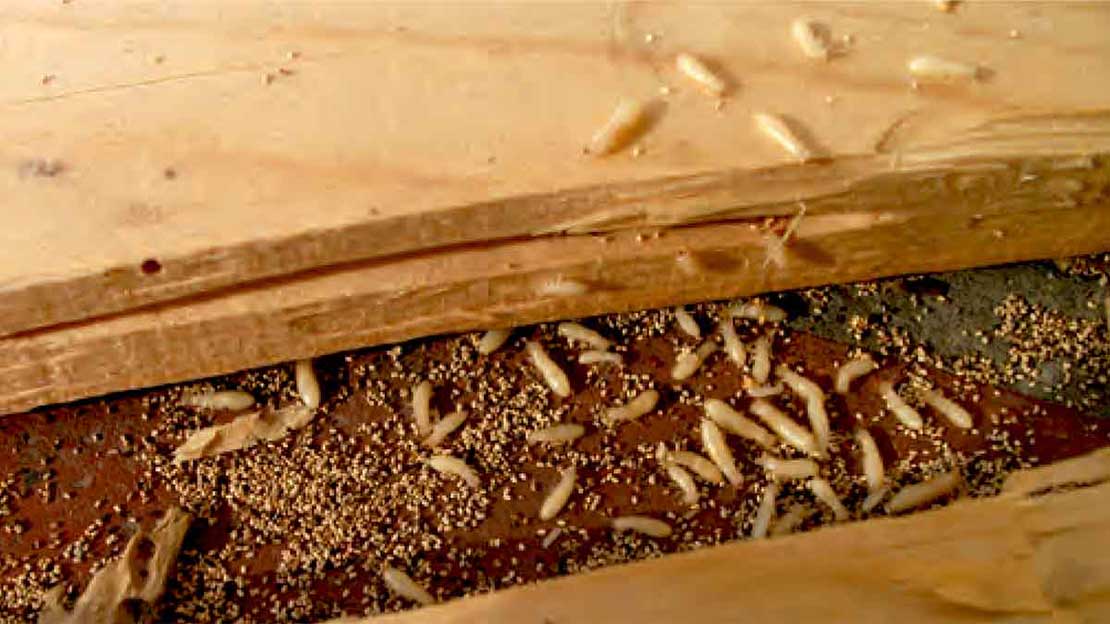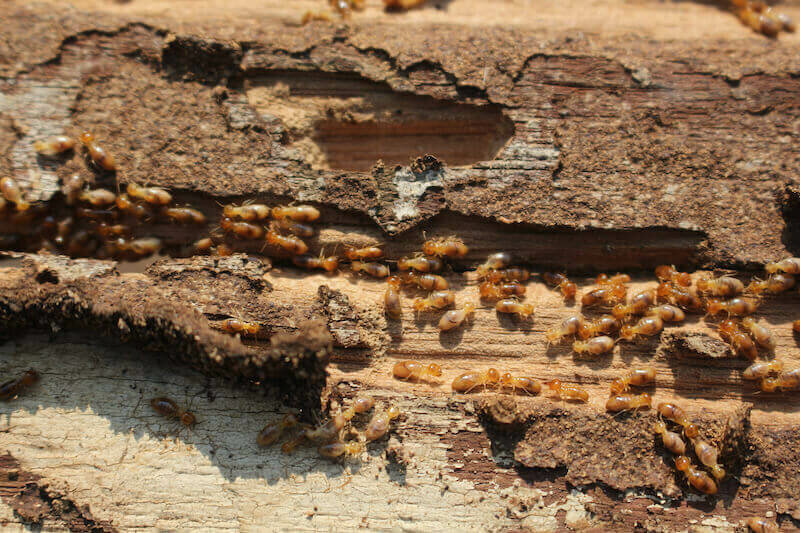Florida’s subtropical environment featuring warm temperatures, elevated humidity, and typically mild winters allows termites to remain active and continuously feed on wood structures. In Pensacola, a prominent Gulf Coast city in the Florida Panhandle, these wood-destroying insects can easily invade homes, short-term rentals, or commercial properties if occupant or manager vigilance wanes. By the time suspicious holes, mud tubes, or hollow-sounding wood appear, termites may have quietly compromised floors, support beams, or interior walls. This page clarifies why termites thrive in Florida, how to detect them early, and why engaging a professional termite exterminator is the most reliable way to protect your property from destructive, concealed termite activity.
Whether you manage a house in Pensacola or rental units also servicing Cantonment or Molino, recognizing termite signs promptly and employing specialized, multi-stage solutions defends occupants from extreme structural damage, inflated repair bills, and repeated do-it-yourself efforts that frequently miss unseen nest expansions or newly laid eggs behind walls or below floors.
Why Termites Thrive in Florida
Mild Winter Temperatures
In colder regions, freezing months hamper or reduce termite populations for extended periods. Florida’s gentle cold season rarely reaches freezing, allowing termites to forage and reproduce year-round. Climate-controlled interiors (around 65–85°F) further remove seasonal interruptions, enabling termites at each stage egg, larva, soldier, worker to progress unless occupant or manager measures halt them.
Dampness & Warmth
Subterranean termites require moisture for building mud tubes and sustaining colonies, whereas drywood termites slip in through cracks to inhabit attic beams or furniture. Florida’s periodic rains, lawn irrigation, or minor water leaks provide substantial humidity for subterranean termites. Drywood termites only need minimal moisture indoors, nesting discreetly behind walls or in wooden rafters.
Plentiful Wooden Structures
From framing lumber and baseboards to fences and decks, Florida properties typically feature abundant wood-based materials. If occupant or manager detection is delayed, termites devour wood from within, weakening support beams or floors over time.
Rapid Colony Growth
A single termite queen can lay countless eggs daily, with eggs hatching in mere weeks under Florida’s mild climate. Subterranean termites especially expand their underground galleries into adjacent wood, while drywood species infiltrate multiple wooden beams if occupant or pro actions don’t stop them. What may appear as a small cluster quickly escalates into multi-room infiltration.

Signs of a Termite Infestation
- Mud Tubes
- Pencil-thin mud tunnels along foundation walls, crawl space supports, or wooden beams.
- Subterranean termites travel in these earthen tubes to retain dampness while seeking wood.
- Pencil-thin mud tunnels along foundation walls, crawl space supports, or wooden beams.
- Discarded Wings
- Winged termites (swarmers) shed clear wings after mating, leaving small piles near windowsills or light sources.
- Indicates a newly formed or nearby termite nest.
- Winged termites (swarmers) shed clear wings after mating, leaving small piles near windowsills or light sources.
- Hollow or Damaged Wood
- Termites consume wood internally, leaving a fragile exterior that sounds hollow if tapped.
- Slight blistering or peeling paint can conceal interior termite galleries.
- Termites consume wood internally, leaving a fragile exterior that sounds hollow if tapped.
- Drywood Termite Frass
- Tiny, ridged pellets resembling sawdust found around small holes in beams or furniture.
- Suggests drywood termites actively discarding their excrement outside their tunnels.
- Tiny, ridged pellets resembling sawdust found around small holes in beams or furniture.
- Swarmers
- Winged termites emerging in warm, humid weather to begin new colonies.
- Spotting swarmers indoors implies a mature nest in or close to your structure.
- Winged termites emerging in warm, humid weather to begin new colonies.
- Stuck or Difficult Windows/Doors
- Damaged or moist wood frames swell, making windows or doors tough to open.
- Combined with other evidence, it strongly indicates concealed termite tunneling or moisture infiltration.
- Damaged or moist wood frames swell, making windows or doors tough to open.
Why Neglecting Termites Is Dangerous
Structural Compromise
Termites gnaw wood from within, undermining beams, joists, or floorboards. Overlooking them leads to sagging floors, cracked walls, or partial collapse, forcing occupant relocation or substantial reconstructions.
Colony Spread
Subterranean termites in particular build extensive underground networks, infiltrating adjoining properties if occupant or management detection is lacking. Drywood termites develop hidden satellite nests in rafters or furnishings, quietly extending into new areas.
Inflated Repairs & Treatment Costs
Minor termite issues found early may only need partial foam or spot fumigation. Delaying until colonies saturate behind walls or multiple floors often compels occupant displacement for entire-structure fumigation or repeated chemical applications, heightening inconvenience and total expenses.
Anxiety & Insurance Gaps
Standard homeowner’s policies often exclude termite damage, leaving owners solely responsible for repair bills. Anxiety over unseen wood destruction behind walls also intensifies occupant stress until professionals confirm termite removal.

Why a Professional Termite Exterminator Is Crucial
Extensive Inspections
A termite exterminator checks foundations, crawl spaces, attics, or yard edges for mud tubes, droppings (frass), or compromised wood. Determining subterranean vs. drywood termites decides whether fumigation, soil termiticides, or localized foam injections are best.
Colony-Wide Elimination
DIY termite sprays only kill surface insects, leaving hidden nests or queens behind walls. Professional termite solutions often comprise:
- Soil Termiticides: Forming protective barriers around or under foundations for subterranean types.
- Bait Stations: Slow poisons worker termites share with the nest, gradually eradicating the colony.
- Fumigation (Tenting): Used for large or widespread drywood termite invasions.
- Localized Treatments: Foams or liquids injected into smaller, confirmed pockets.
Safe, Regulated Application
Misusing chemicals jeopardizes occupant or pet well-being. Certified exterminators apply termiticides meticulously trenching near foundations, sealing entire buildings for fumigation, or injecting foam into beams delivering lethal termite contact while guarding occupant safety.
Moisture & Entry Control
Subterranean termites rely on damp soil. Occupant synergy repairing leaks, directing water away from foundations disrupts termite survival. Drywood termites typically enter attics via roof cracks; sealing eaves or vents blocks re-entry after extermination.
Monitoring & Warranties
Many termite exterminators provide occupant service plans or annual checks, addressing any emergent tubes, droppings, or swarmers quickly. Occupants gain confidence knowing fresh intrusions receive swift treatments, preserving a termite-free property year-round.
Typical Methods for Termite Treatments
- Inspection & Species Identification
- Professionals investigate crawl spaces, foundations, or attic beams for mud tubes, frass, or hollow wood.
- Determining subterranean vs. drywood shapes whether entire-structure fumigation, soil termiticide barriers, or localized foam works best.
- Professionals investigate crawl spaces, foundations, or attic beams for mud tubes, frass, or hollow wood.
- Soil Termiticides
- For subterranean termites, exterminators create chemical barriers around foundations, injecting termiticide into trenches or drilled holes.
- Termites foraging through treated soil bring poison to their nest, collapsing the colony.
- For subterranean termites, exterminators create chemical barriers around foundations, injecting termiticide into trenches or drilled holes.
- Bait Stations
- Placed around the property perimeter, slow-acting baits let worker termites feed and distribute the poison to the queen and colony, wiping them out in weeks or months.
- Placed around the property perimeter, slow-acting baits let worker termites feed and distribute the poison to the queen and colony, wiping them out in weeks or months.
- Fumigation (Tenting)
- Suited for multi-room or advanced drywood termite cases. The property is enclosed, and gas saturates wood layers.
- Occupants vacate briefly; returning once the environment is fully ventilated and termite-free.
- Suited for multi-room or advanced drywood termite cases. The property is enclosed, and gas saturates wood layers.
- Localized Treatments
- Smaller drywood pockets may only need foam or spot injections.
- Follow-up ensures no hidden expansions or overlooked satellite nests continue feeding.
- Smaller drywood pockets may only need foam or spot injections.
- Moisture & Wood Fixes
- Subterranean termites thrive in damp soil. Occupants or managers fix leaks, slope soil away from foundations, or replace wet, compromised wood.
- Drywood termites slip in via roof eaves or attic cracks sealing them denies further infiltration.
- Subterranean termites thrive in damp soil. Occupants or managers fix leaks, slope soil away from foundations, or replace wet, compromised wood.
- Annual Inspections & Plans
- Frequent occupant or professional checks detect emergent mud tubes, frass, or swarmers.
- Rapid occupant response to suspicious signs halts new colonies well before structural risks become severe.
- Frequent occupant or professional checks detect emergent mud tubes, frass, or swarmers.
- Inspection & Species Identification

Service Area: Pensacola, Cantonment, Molino
While termites prosper statewide in Florida’s mild winter, this page specifically tackles solutions for Pensacola, plus Cantonment and Molino areas needing occupant synergy plus specialized termite treatments to eliminate or prevent termite expansion. Florida’s gentle cold season barely restrains termites, so occupant readiness and professional extermination remain critical to defend your structure from these wood-consuming intruders.
Why Choose Us
Florida-Calibrated Strategies
We employ recognized termite solutions soil termiticides, fumigation, bait stations aligned with Florida’s environment. Pairing occupant synergy (like moisture control or sealing cracks) ensures thorough coverage surpassing occupant attempts that often miss concealed queen-laying processes behind walls or under floors.
In-Depth Property Reviews
Before applying chemicals, technicians meticulously evaluate foundations, attics, or basements for mud tubes, compromised wood, or discarded wings. Subterranean vs. drywood (or Formosan) distinctions clarify whether partial foam or entire-structure fumigation best fits occupant needs.
Safe & Exact Chemical Usage
Professionals use insecticides responsibly like trenching near foundations for subterranean nests, or tenting entire structures for advanced drywood cases safeguarding occupants. Local foam injections remain within specific galleries, ensuring lethal doses for termites while curtailing occupant chemical exposure.
Moisture & Entry Prevention
Once colonies are eradicated, occupant synergy addressing leaks, removing wood-soil contact prevents subterranean termite re-infiltration. Sealing eaves, attic vents, or roof cracks denies drywood swarmers. Florida’s mild winter seldom curbs termites, so occupant synergy fosters lasting termite resistance.
Monitoring & Warranties
Because new colonies might sprout later, many termite exterminators offer occupant warranties or periodic checks. Occupants feel reassured if emergent mud tubes or droppings appear, guaranteeing immediate re-treat. Occupant synergy plus annual inspections maintain a termite-free property under Florida’s persistent termite-favorable climate.
Next Steps
Discovering mud tubes on your foundation, hollow-sounding beams, or discarded swarmer wings near windows? Contact us to learn more or schedule your service. Our termite treatments for Pensacola and nearby Cantonment, Molino blend rigorous property assessments, recognized control methods (soil termiticides, fumigation, bait stations, localized foam), occupant-driven moisture management, plus vital re-checks fully decimating active colonies while preventing new ones.
Act swiftly to protect occupants from deeper wood damage, occupant worry over unseen termite foraging, and potential insurance gaps not covering termite destruction. Rely on our Florida-based termite exterminator expertise to locate, eradicate, and deter these stealthy feeders, preserving your property’s integrity despite Florida’s mild winter environment fueling year-round termite feeding cycles.
